Boldly Representing Rainbow Geeks since Star Date 22766.5 (If you don’t know, now you know)
Disclaimer: This may be the most underrated Star Trek series ever. It was the first to be serial rather than episodic, and it is highly nuanced and political. There were a ridiculous number of episodes I wanted to list, but worked hard to narrow it down.
Busy Geek Breakdown:
Lifelong Trekkie or never seen a single episode? Check out the following:
Season 3; Episode 18. Season 4; Episode 6. Season 6, Episode 23. Season 7, Episode 8, Episode 13.
Also, if you just want to see Captain Sisko being a badass, click here.
If you want to see how DS9 crew deals with Time Travel (or want to see Jadzia Dax in a Skant and updo Stanning Kirk), click here.
If you’re a seasoned Trekkie, or are just one of those people who always clicks ‘Jump to the Recipe’ right away — click here.
For total Star Trek Redshirts Provisional Ensigns Red Squad Cadets (and if you’re thinking ‘but the Red Squad was elite!’ yes, I know. But how did that work out for them. Hmmmm? Exactly Just go with it):
DS9 is a science fiction television series that aired from 1993 to 1999. It is set in the Star Trek universe and takes place on a space station called Deep Space Nine, which is located near a stable wormhole that provides access to a distant part of the galaxy.
This overlapped with The Next Generation, as a sequel to The Original Series. There are plenty of crossover episodes, and you’ll definitely see some of your favorite characters.
The main character of the series is Commander Benjamin Sisko (played by Avery Brooks ‘we both went to Indiana University so I guess I’m kind of a big deal by proxy), who is tasked with overseeing the station and maintaining relations with the various alien species that visit it. Sisko is joined by a diverse crew, including his first officer, Major Kira Nerys, the station’s doctor, Julian Bashir, the shapeshifter Odo, the Ferengi bartender Quark, and the human Chief of Operations, Miles O’Brien.
Over the course of the series, the crew of DS9 faces a variety of challenges and conflicts, including battles with the Dominion, a powerful empire from the Gamma Quadrant, and the Cardassians …
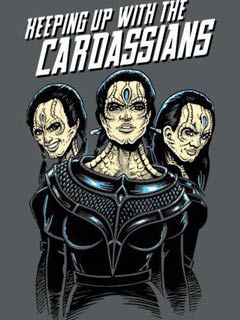
no, not them …
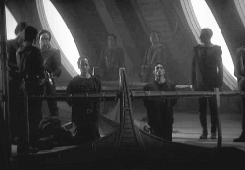
These fun folks. An aggressive alien race (that previously tortured the shit out of Picard) that once occupied the station. They also deal with political intrigue, moral dilemmas, and personal struggles, all while exploring the far reaches of the galaxy and encountering new and fascinating alien civilizations.
It’s worth noting that while these episodes were groundbreaking for their time, they may not be considered entirely inclusive by modern standards, and some may find them problematic.
Overall, these episodes are all important contributions to queer representation in popular culture. And the costumes and makeup only add to the symbolism and power of these stories.
Throughout the series, DS9 tackles complex themes and issues, including war, religion, politics, and social justice. It also features a diverse cast of characters and a strong emphasis on character development and relationships.
Overall, Star Trek: Deep Space Nine is a rich and engaging science fiction series that explores the depths of the human (and alien) experience, while taking viewers on an unforgettable journey through the final frontier.
Star Trek: Deep Space Nine (DS9) was a trailblazing show in terms of its representation of LGBTQ+ characters. The series tackled themes of identity, acceptance, and love in a way that was ahead of its time. Here are the six best episodes of Star Trek DS9 that feature LGBTQ+ characters, listed in chronological order of air date: (Onward to the numbered list! Yaaass!!!)
6. “Distant Voices” (Season 3, Episode 18)
Aired on April 10, 1995, “Distant Voices” Dr. Julian Bashir (Alexander Siddig) is attacked and rendered unconscious in his own infirmary. When he wakes up, he finds himself aging rapidly and experiencing hallucinations of his friends and colleagues turning against him, as the space station appears to be failing and nearly everyone is dead or gone. As he tries to figure out what’s happening to him, he realizes that his mind is trapped in a telepathic matrix created by the Letheans, a species known for their telepathic abilities. He eventually realizes that he can fight back inside his own mind and takes charge.
So first, I felt old watching this episode because Dr. Bashir makes a huge deal about turning 30.
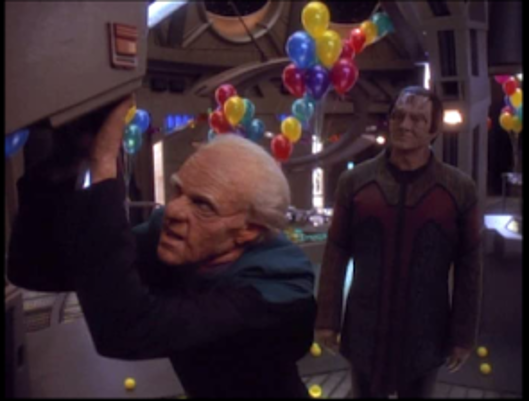
Owner/Creator: Paramount Global (was ViacomCBS and/or Paramount Pictures and/or CBS Broadcasting, Inc.)
That aside, It’s not only a great episode about the Tao of Dr. Bashir, embodied in different characters (if a little on the nose at times) but it While Julian Bashir and Garak (Andrew J. Robinson) did not share a romantic relationship, their friendship was still significant for its portrayal of intimacy between two men. In the 1990s, when Star Trek: Deep Space Nine was airing, depictions of close male friendships were often limited to stereotypes of toxic masculinity, with emotions and physical touch seen as signs of weakness.
However, Bashir and Garak’s relationship subverted these norms. They shared moments of vulnerability, empathy, and even physical affection, without any implications of romantic or sexual attraction. This representation of a healthy, non-romantic male relationship was rare on television at the time, and it challenged harmful stereotypes of masculinity.
Their relationship also touched on themes of identity and acceptance, as Garak was a Cardassian spy with a complicated past and Bashir struggled with the expectations of being a genetically enhanced human. Their friendship allowed them to navigate their personal challenges and grow as individuals.
Overall, while their relationship may not have been explicitly LGBTQ+, it was still significant for its representation of intimacy and vulnerability between two men, and for subverting harmful stereotypes of masculinity. Of course there’s always Rule 34, so while I haven’t specifically gone searching, I am sure there’s lots of Fan Fiction that imagines their relationship differently . . .
What were we doing? Oh right, the episode.
Why are they playing tennis in the middle of the station? Why so we can get some much needed exposition, duh!
And of course there’s a very surreal surprise party thrown by a lady in a cat suit with huge hair, and imaginary Garak.

Owner/Creator: Paramount Global (was ViacomCBS and/or Paramount Pictures and/or CBS Broadcasting, Inc.)
Gayest episode ever? No. But it’s definitely a great example of intimacy, self examination, and finding one’s inner truth and value without all the machismo.
5. “Rejoined” (Season 4, Episode 6)
Aired on October 30, 1995, “Rejoined” is considered one of the most groundbreaking LGBTQ+ episodes in television history. In the episode, Jadzia Dax (Terry Farrell) meets her former wife, Lenara Kahn (Susanna Thompson). The two women had been married in previous host bodies. The episode’s exploration of love, relationships, and gender identity was a groundbreaking moment for LGBTQ+ representation on television.
Trill society frowns upon rekindling past romantic relationships after a host’s symbiont has been transferred to a new host, to the point where it is effectively a death sentence (as the symbiont will only live as long as the current host does) and the two must navigate the societal taboo against their feelings for each other.
This episode is groundbreaking! It’s one of the first times Star Trek has directly dealt with same-sex relationships, and it’s done in a way that’s respectful and nuanced. Jadzia and Lenara’s relationship is so tender and sweet, and you can really feel the love between them. And when they kiss – honey, I got chills! But what’s really powerful is the way the episode deals with the taboo of their relationship. It’s a metaphor for the way society can try to suppress queer love, but it’s also a message of hope that love will always find a way!
Now, I don’t know about you, but I’m always here for some queer representation in media, and “Rejoined” delivered. You can really see the tension in Jadzia’s face as she struggles with her feelings for Lenara. We need to see more LGBTQ+ characters on our screens, not just for visibility but to show that love is love, no matter who it’s between.
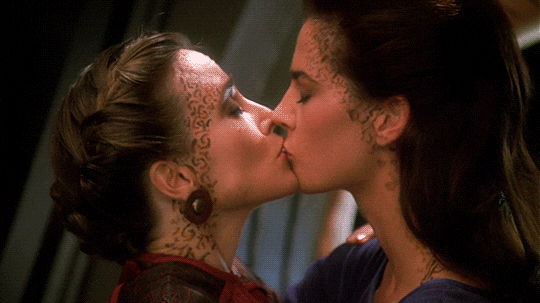
Now, let’s talk trans rights, because the character of Dax raises some interesting questions about gender and identity. As a Trill, Dax is a symbiont that lives inside a humanoid host. In the episode, she’s reunited with her former female host, Lenara Kahn, and the two rekindle their romantic relationship. The fact that Dax is a symbiont raises interesting questions about the fluidity of gender and identity. The show doesn’t delve too deeply into these themes, but it’s still worth thinking about.
Of course, we can’t forget the forbidden love aspect of the episode. Dax and Lenara’s relationship is forbidden because Trill society frowns upon rekindling a relationship with a former host. It’s a classic Romeo and Juliet story, but with a sci-fi twist. And let’s be honest, who doesn’t love a good forbidden love story? It’s like catnip for drama queens like me!
Now, the sexual tension between Dax and Lenara is thicker than a day time drag queen’s foundation. You can cut it with a knife! And let’s not forget that both Dax and Lenara have had multiple hosts over the years. It’s like an intergalactic version of an ex-spouse reunion! Can you imagine the drama if they got together and started fighting about who gets custody of their former hosts’ memories?
“Rejoined” is a must-watch for any sci-fi or LGBTQ+ fan. It’s a groundbreaking episode that tackled important themes ahead of its time, and it’s still relevant today.
Also, there are some more great moments with CDR Worf in this episode, like when at a cocktail party with a bunch of Trill scientists, they ask what Klingons dream of.
And thanks to a really sweet exchange between Dax and Lanara, we learn a bit about Klingon Fashion.
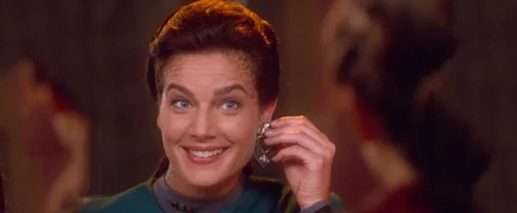
Owner/Creator: Paramount Global (was ViacomCBS and/or Paramount Pictures and/or CBS Broadcasting, Inc.)
And let’s not forget about our dear friend Ben Sisko! As the commander of Deep Space Nine, he’s always there for his crew, no matter what kind of intergalactic drama they’re going through. He’s a true friend, and we could all use a friend like him in our lives.
But as Captain Sisko, he’s got to keep his crew in line! I mean, come on, if Dax and Lenara had gotten caught, it could have meant the end of their careers, or worse! Maybe he needs to have a talk with his first officer about following the rules. Or maybe he needs to loosen up a bit himself! He’s apparently already on a first name basis with many of his subordinate officers. Oh Well. After all, life is short, and love is a beautiful thing, even if it’s forbidden.
Unfortunately, it’s not always meant to be. Sometimes the pressures of society are too much even for true love. Just heartbreaking.
In any case, “Rejoined” is a classic episode that shows us the power of love, the importance of friendship, and the beauty of a good, juicy sci-fi storyline. So, grab some popcorn, settle in, and get ready for some intergalactic drama!
4. “Profit and Lace” (Season 6, Episode 23)
Aired on May 13, 1998, “Profit and Lace” is a controversial episode that features the character of Quark (Armin Shimerman) having a gender-reassignment surgery in order to impersonate a female member of his species. While the episode has been criticized for its problematic portrayal of gender identity, it was a significant moment for LGBTQ+ representation on television.
Before we dive into the gender and identity themes of “Profit and Lace,” we have to address the elephant in the room: Quark’s problematic behavior at the beginning of the episode. It’s true that the episode starts with Quark engaging in quid pro quo sexual harassment of his star Dabo girl, Leeta. This behavior is creepy, inappropriate, and not at all okay. It’s important to acknowledge that this kind of behavior is not acceptable, and should not be normalized or trivialized.
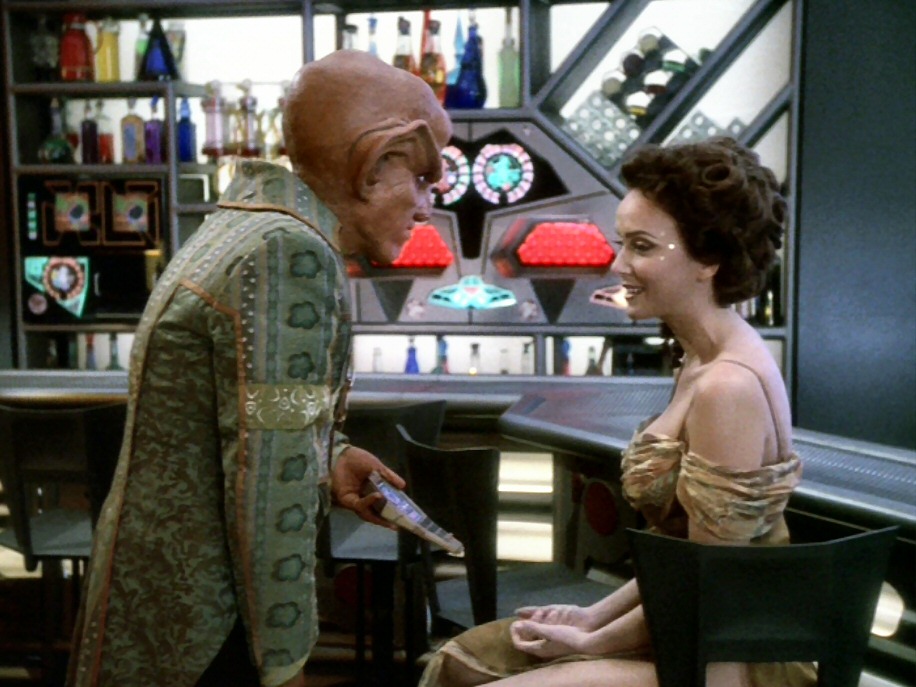
Owner/Creator: Paramount Global (was ViacomCBS and/or Paramount Pictures and/or CBS Broadcasting, Inc.)
Quark apparently skipped every single training that Star Fleet Human Resources had ….
That being said, the episode does not condone Quark’s behavior. In fact, it goes out of its way to show how damaging and hurtful this kind of behavior can be. When Quark is forced to pose as a female, he experiences firsthand the discrimination and harassment that women face in Ferengi society. This experience teaches him empathy and understanding, and he ultimately comes to recognize the harm that his previous behavior has caused.
So, while “Profit and Lace” certainly has its flaws, it’s also a story of growth and redemption. It’s not perfect, but it does offer some interesting commentary on gender and identity, and it’s worth watching for that reason alone.
I initially thought that this was going to be a Bird Cage situation, but to my surprise, Quark undergoes the fastest medical transition ever thanks to Dr. Bashir – and is now Lumba. The surgery does not change her voice, and she has to learn how to walk in heels. Of course the episode begins with Moogi getting the Grand Nagus to ammend the laws so Ferengi women can now wear clothes in public, challenging the traditional gender roles of Ferengi society.
Now, let’s talk about the costumes and makeup. Lumba serves up nothing but executive Ferengi realness!
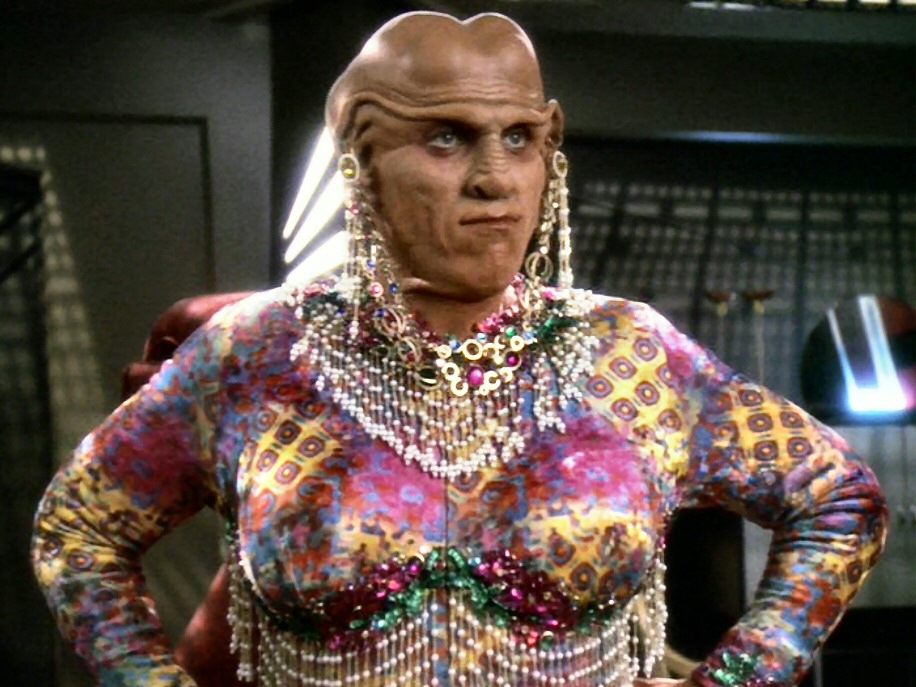
Owner/Creator: Paramount Global (was ViacomCBS and/or Paramount Pictures and/or CBS Broadcasting, Inc.)
But at the same time, it’s like a commentary on how women are expected to conform to certain beauty standards. And when Quark transforms back into a man at the end of the episode, honey, it’s like a symbol of breaking free from those oppressive gender norms.
Oh, honey, where do I even begin with this one? This episode is a wild ride from start to finish! The gender-swapping plot is played for laughs, but there’s also some serious commentary on gender roles and societal norms. It’s a reminder that gender is a social construct, and that there’s no one right way to be a man or a woman. Ultimately Lumba is able to get the Ferengi Commerce Authority to change their sexist policies. It’s a powerful message of activism, truly owning someone’s struggle, and standing up for what’s right. And let’s not forget about the fabulous costumes and set design – those Ferengi outfits and all of the jewels!
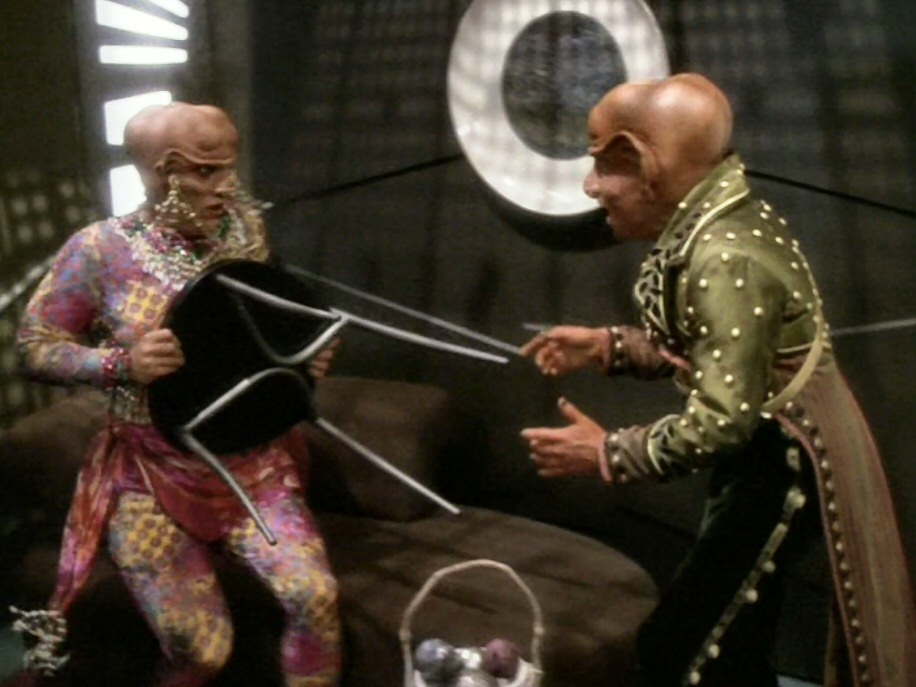
Owner/Creator: Paramount Global (was ViacomCBS and/or Paramount Pictures and/or CBS Broadcasting, Inc.)
And at the end, not only did Lumba save the day, but following another fast medical transition (medicine in the 24th century is awesome!) Quark has gained some perspective and starts speaking respectfully to the Dabo girl from the beginning of the episode, gives her a raise, and even turns down her advances.
Even though parts of this were clearly played for the comic misunderstandings, at the end of the day, there’s very little backlash for Quark – Lumba – Quark, and their Moogi even says “You may not have been much of a son, but you made an amazing daughter”.
3. “The Siege of AR-558” (Season 7, Episode 8)
Aired on November 18, 1998, “The Siege of AR-558” on the surface is not on the surface about LGBT issues, but let me tell you why you’re wrong. (I have opinions!!!!)
This episode is a perfect example of the darkest days of the Dominion Wars, as a few survivors are protecting a communications relay from the Jem’Hadar
The events of “The Siege of AR-558” remind us that the struggle for equality and justice is ongoing and often painful. The queer community knows all too well what it means to fight against overwhelming odds and suffer profound loss. We have faced violence, oppression, and discrimination throughout our history, from Stonewall to the HIV pandemic, Drag bans, assaults on trans rights and beyond.
But this episode also shows us that change is possible, and that we are stronger when we have co-conspirators rather than passive allies. The crew of Deep Space Nine learned this the hard way, as they were thrust into the front lines of a brutal war and forced to confront the realities of combat. They came to realize that the struggle for justice is not a distant abstract concept, but something that affects real people on the front lines.
This lesson is especially important for allies of the queer community. It’s not enough to simply say that you support us or that you are against discrimination. Real change requires action, and it requires a willingness to fight alongside us. We need co-conspirators who are willing to put themselves on the line and take risks for the sake of justice.
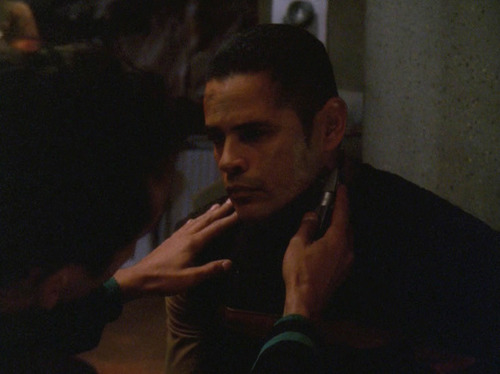
Owner/Creator: Paramount Global (was ViacomCBS and/or Paramount Pictures and/or CBS Broadcasting, Inc.)
On a brighter note, Raymond Cruz makes an appearance who you might know as Tuco from Breaking Bad and Better Call Saul.
2.”Field of Fire” (Season 7, Episode 13)
Aired on February 17, 1999, “Field of Fire” In “Field of Fire,” a murder mystery unfolds on Deep Space Nine when a series of crew members are killed by a seemingly random attacker. Lieutenant Ezri Dax assists in the investigation, which leads to the discovery of a Vulcan officer who survives the slaughter of his crew, and becomes a logic extremist, dealing death to folks who find joy and laughter as he struggles with survivor guilt.

Also, Dax’s old forgotten host is super creepy …
The episode touches on issues of trust, betrayal, and trauma as the characters grapple with the consequences of one’s actions. It also highlights the importance of seeking help and support when dealing with difficult emotions and experiences.
In terms of its relation to the LGBT community, the episode does not have any overt references to LGBT themes or characters. However, the underlying themes of identity, repression, and acceptance could be seen as resonating with the struggles faced by many members of the Queer community. For example, the idea of feeling forced to hide one’s true identity or desires due to societal pressures or expectations is a common experience for many in the Queer community.
The episode’s message of the importance of being true to oneself and seeking help when needed could therefore be seen as relevant and empowering. And ultimately Dax has to rely on multiple aspects of themselves and trust their instincts to solve the murder, while keeping a cool head to ensure that justice is done.
1. “Chimera” (Season 7, Episode 14)
This standout episode of Star Trek: Deep Space Nine explores themes of identity, belonging, and acceptance. The episode follows the character Odo, a shapeshifter who has always struggled with his place in the galaxy. When Odo is visited by another shapeshifter named Laas, he is excited to meet someone like himself but soon discovers that Laas has a much more militant view of their kind.
Laas believes that shapeshifters should distance themselves from “solids” and not take on their form, which he sees as an act of subservience. Laas also challenges Odo’s decision to remain on Deep Space Nine and serve as a security officer for Starfleet.
As Odo and Laas spend more time together, their relationship becomes increasingly complex. Laas represents a different perspective on what it means to be a shapeshifter, and Odo is forced to confront his beliefs about his identity and place in the galaxy. The episode touches on themes that resonate with the LGBTQ community, particularly the struggle to balance the desire to make others comfortable with the need to be true to oneself, as many on the station are notionally alright with shapeshifters as long as it stays behind closed doors. Quark says this bluntly to Odo.
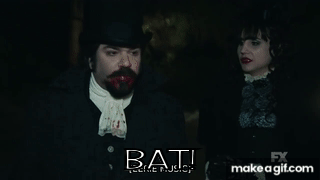
Wait, wrong shape shifter ….
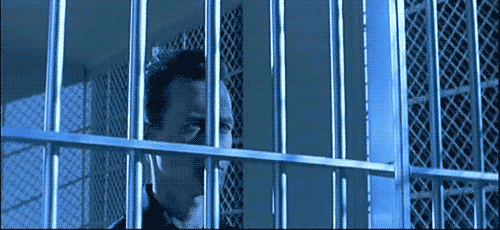
Wait, not that one either….
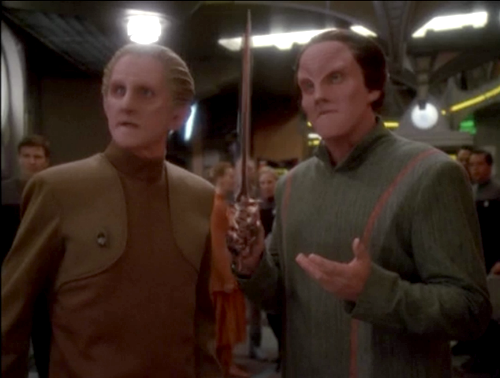
Owner/Creator: Paramount Global (was ViacomCBS and/or Paramount Pictures and/or CBS Broadcasting, Inc.)
There we go. Anyway, they attack him, and he retaliates by transforming his arm into a sharp blade to kill one of the Klingons. This sequence adds tension and action to the episode and highlights the complex relationships between different species in the Star Trek universe.
As for the other themes in the episode, it does explore the LGBT community through the relationship between Odo and Laas. Kira initially struggles with jealousy when Odo and Laas join in a link (unique to metamorphs and incredibly intimate), but she ultimately supports him in his journey of self-discovery.
The performances in the episode are excellent, particularly by Rene Auberjonois as Odo and J.G. Hertzler as Laas. The episode raises important questions about the use of violence in political movements and the consequences of such actions, including how the justice system may not be fair to those who defend themselves from violence while the violence itself is ignored. It also explores the theme of acceptance and the importance of embracing diversity. Overall, “Chimera” is a well-crafted and thought-provoking episode worth watching.
She eventually even puts her career at risk to help Odo, but he decides to stay with her and share his whole self with her, surrounding her with fog and brilliant lights in a lovely moment of vulnerability.
Star Trek DS9 was a groundbreaking show when it came to LGBTQ+ representation on television. These six episodes explored themes of identity, acceptance, and love in a way that was ahead of its time. They are a testament to the power of storytelling to break down barriers and promote understanding and acceptance. By listing these episodes in chronological order of air date, we can see how the series gradually evolved and pushed the boundaries of what was acceptable for LGBTQ+ representation on television.
If you’re a fan of Star Trek DS9, these episodes are a must-watch, not only for their historical significance but also for their powerful storytelling and complex characters. And if you’re not a fan yet, give them a chance and see how this groundbreaking show tackled issues of diversity and inclusion decades before it became mainstream.
Remember, representation matters, and shows like Star Trek DS9 paved the way for a more diverse and inclusive media landscape. We still have a long way to go, but by celebrating and highlighting these important moments in television history, we can continue to move forward and make progress towards a more accepting and compassionate world.
Title Image includes Altered (with permission): Image by https://pixabay.com//?utm_source=link-attribution&utm_medium=referral&utm_campaign=image&utm_content=2749367"

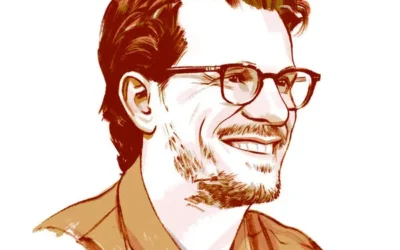

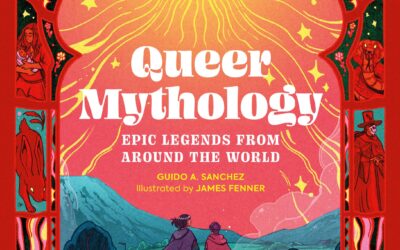
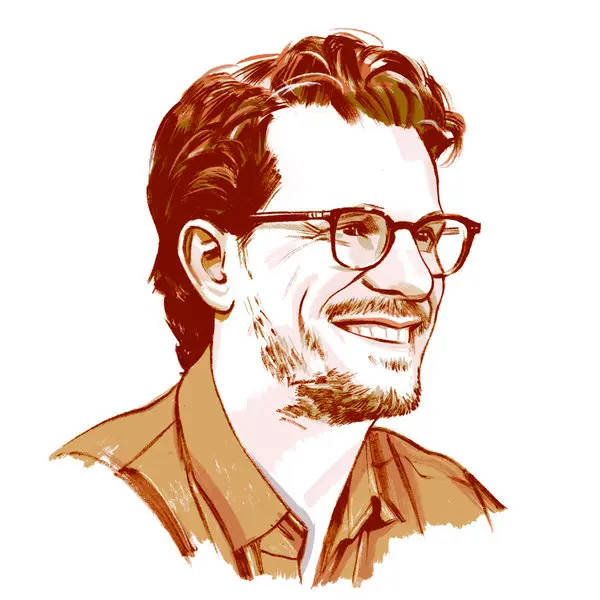
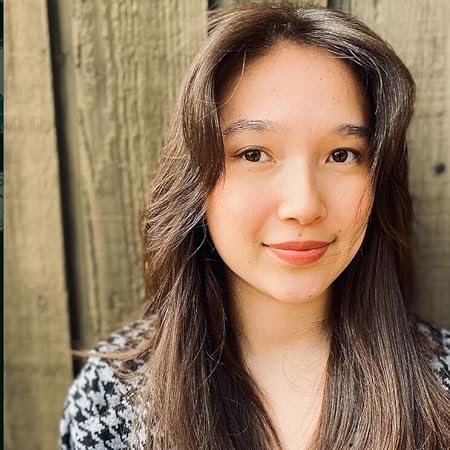
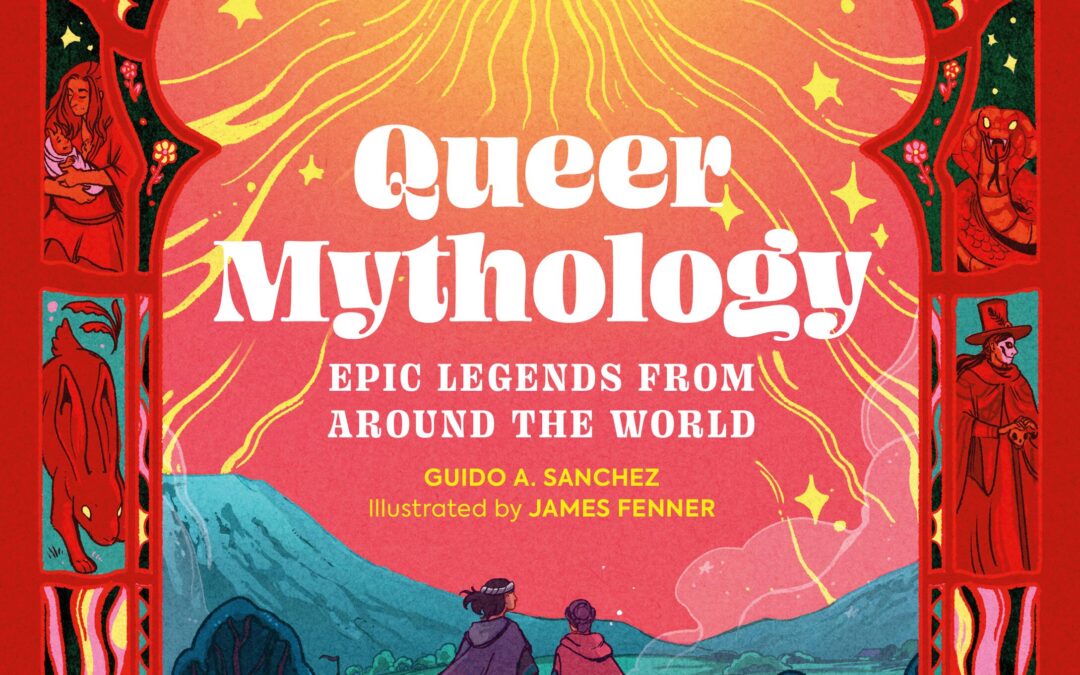
0 Comments